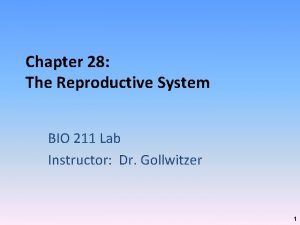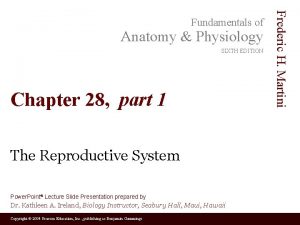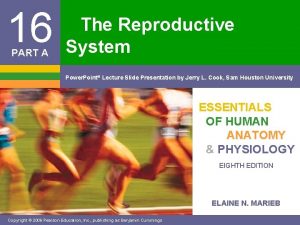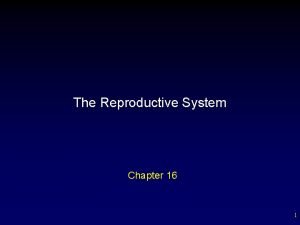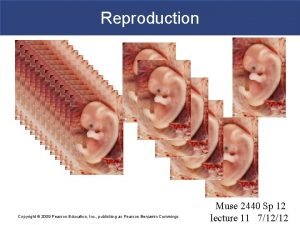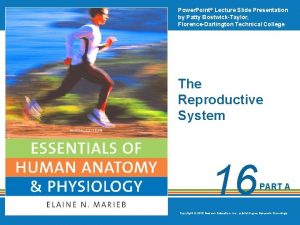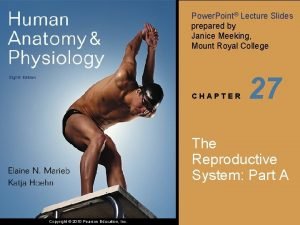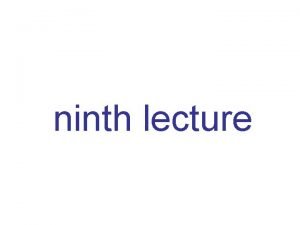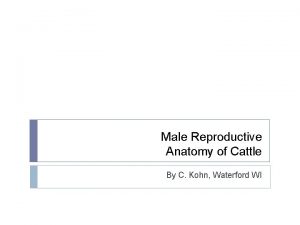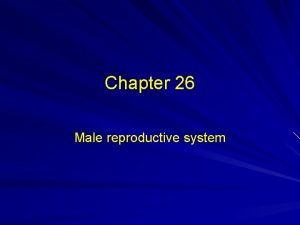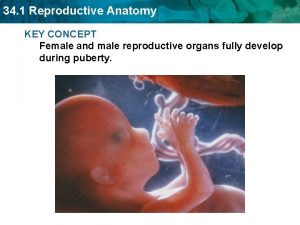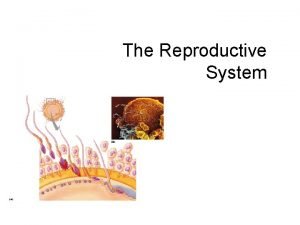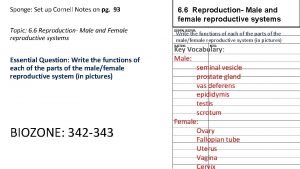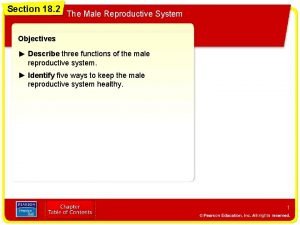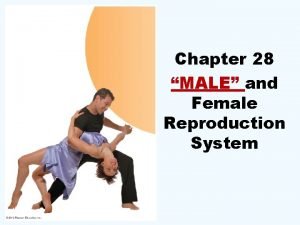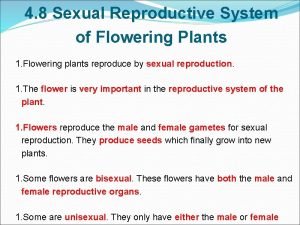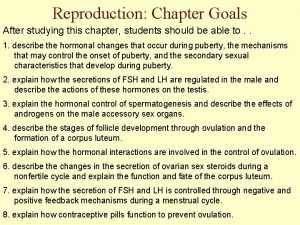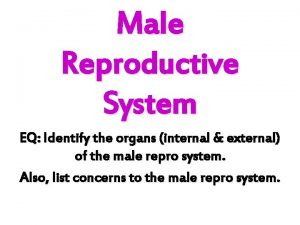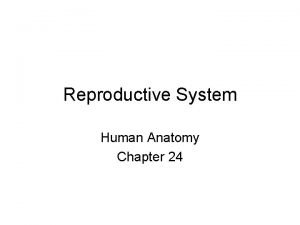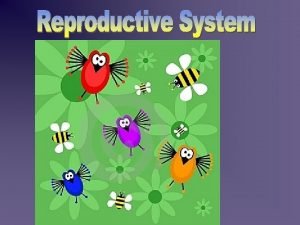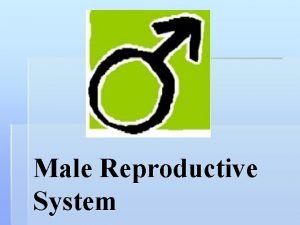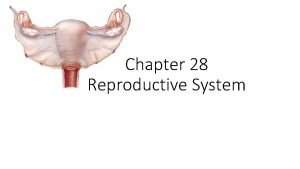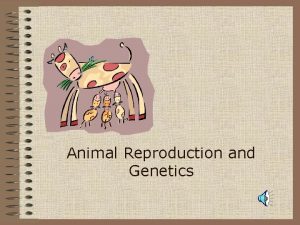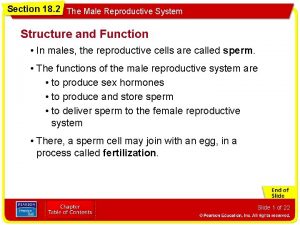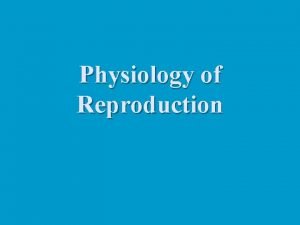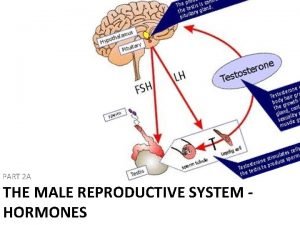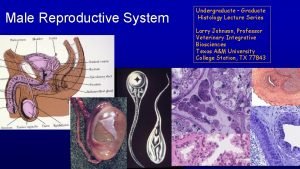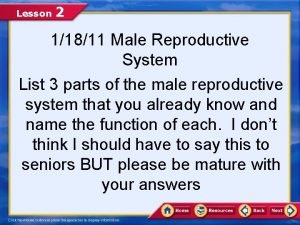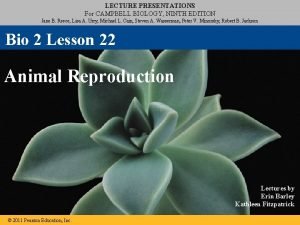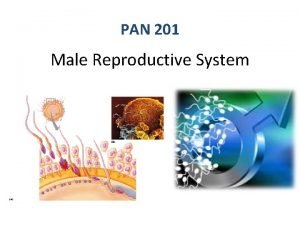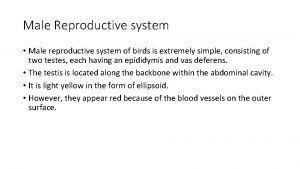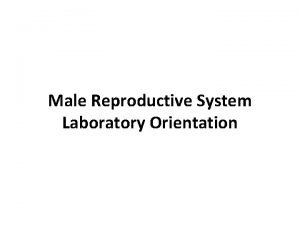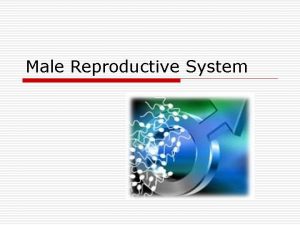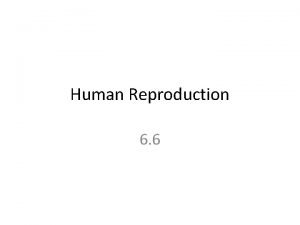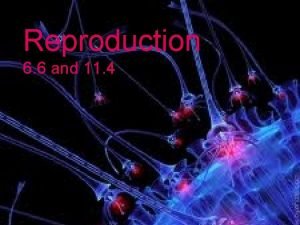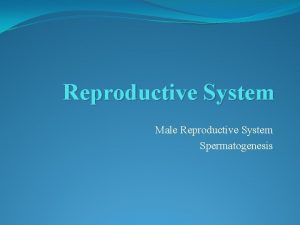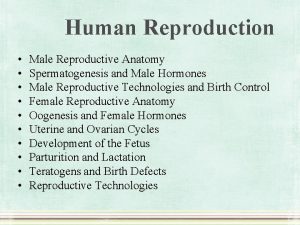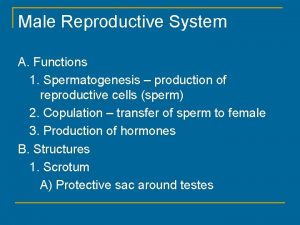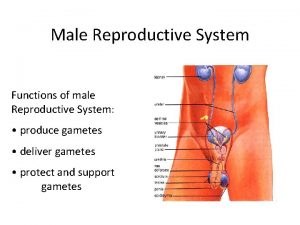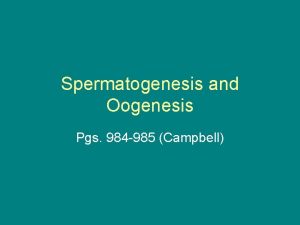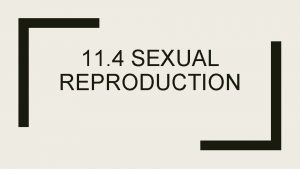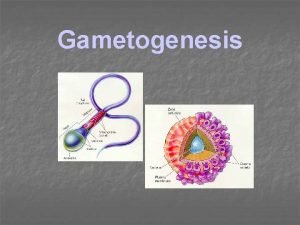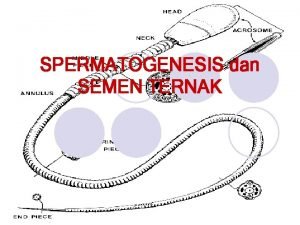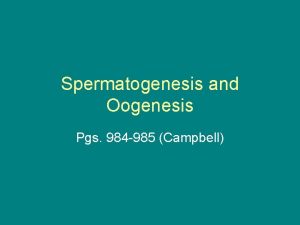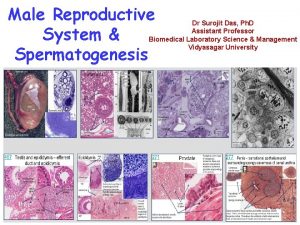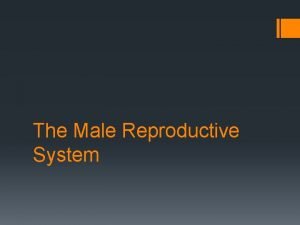Male Reproductive Functions Figure 26 7 Spermatogenesis Male



























































- Slides: 59


Male Reproductive Functions Figure 26– 7 Spermatogenesis.

Male Reproductive Functions • Spermiogenesis – Is the last step of spermatogenesis – Each spermatid matures into one spermatozoon (sperm) • Attached to cytoplasm of nurse cells

Male Reproductive Functions • Spermiation – At spermiation, a spermatozoon • Loses attachment to nurse cell • Enters lumen of seminiferous tubule – Spermatogonial division to spermiation • Takes about 9 weeks

Male Reproductive Functions • Nurse Cells – Affect • Mitosis • Meiosis • Spermiogenesis in seminiferous tubules

Male Reproductive Functions • Six Major Functions of Nurse Cells 1. 2. 3. 4. 5. 6. Maintain blood–testis barrier Support mitosis and meiosis Support spermiogenesis Secrete inhibin Secrete androgen—binding protein (ABP) Secrete Müllerian—inhibiting factor (MIF)

Male Reproductive Functions • Maintenance of Blood–Testis Barrier – Blood–testis barrier isolates seminiferous tubules – Nurse cells are joined by tight junctions that divide seminiferous tubule into compartments • Outer basal compartment contains spermatogonia • Inner lumenal compartment, or adlumenal compartment, is where meiosis and spermiogenesis occur

Male Reproductive Functions • Support of Mitosis and Meiosis – Nurse cells are stimulated by • Follicle-stimulating hormone (FSH) • Testosterone – Stimulated nurse cells promote • Division of spermatogonia • Meiotic divisions of spermatocytes

Male Reproductive Functions • Support of Spermiogenesis – Nurse cells • Surround and enfold spermatids • Provide nutrients and chemical stimuli for development • Phagocytize cytoplasm shed by developing spermatids

Male Reproductive Functions • Inhibin – Is a peptide hormone secreted by nurse cells in response to factors released by spermatozoa – Depresses • Pituitary production of FSH • Hypothalamic secretion of Gn. RH – Regulation of FSH and Gn. RH by Inhibin • Gives nurse cells feedback control of spermatogenesis • After division, increases inhibin production

Male Reproductive Functions • Androgen-Binding Protein (ABP) – Binds androgens (primarily testosterone) • In seminiferous tubule fluid – Is important in • Elevating androgen in seminiferous tubules • Stimulating spermiogenesis – Production of ABP is stimulated by FSH

Male Reproductive Functions • Müllerian-Inhibiting Factor (MIF) – Is secreted by nurse cells in developing testes – Causes regression of fetal Müllerian (paramesonephric) ducts • Help form uterine tubes and uterus in females • In males, inadequate MIF production leads to: – retention of ducts – failure of testes to descend into scrotum

Male Reproductive Functions • Sperm Structure – – Head Neck (attaches head to middle piece) Middle piece Tail

Male Reproductive Functions • Anatomy of a Spermatozoon – Head • A flattened ellipse that contains nucleus and chromosomes • Acrosomal cap at tip of head: – is a membranous compartment that contains enzymes essential to fertilization – made of fused saccules of spermatid’s Golgi apparatus

Male Reproductive Functions • Anatomy of a Spermatozoon – Middle piece • Contains mitochondria: – in spiral around microtubules – activity provides ATP to move tail

Male Reproductive Functions • Anatomy of a Spermatozoon – Tail • Is the only flagellum in the human body – is a whiplike organelle – moves cell from one place to another – has complex, corkscrew motion

Male Reproductive Functions Figure 26– 8 a Spermiogenesis and Spermatozoon Structure.

Male Reproductive Functions Figure 26– 8 b Spermiogenesis and Spermatozoon Structure.

Male Reproductive Functions Figure 26– 8 b Spermiogenesis and Spermatozoon Structure.

Male Reproductive Functions • Mature spermatozoon lacks – Endoplasmic reticulum – Golgi apparatus – Lysosomes and peroxisomes – Inclusions and other intracellular structures • Loss of these organelles reduces sperm size and mass • Sperm must absorb nutrients (fructose) from surrounding fluid

Male Reproductive Functions • Sperm Maturation – Testes produce physically mature spermatozoa that can NOT fertilize an oocyte – Other parts of reproductive system are responsible for • Functional maturation, nourishment, storage, and transport

Male Reproductive Functions • Sperm Maturation – Spermatozoa • Detach from nurse cells • Are free in lumen of seminiferous tubule • Are functionally immature: – are incapable of locomotion or fertilization – are moved by cilia lining efferent ductules into the epididymis

Male Reproductive Functions • Anatomy of a Spermatozoon – Tail • Is the only flagellum in the human body – is a whiplike organelle – moves cell from one place to another – has complex, corkscrew motion

Male Reproductive Functions Figure 26– 8 a Spermiogenesis and Spermatozoon Structure.

Male Reproductive Functions Figure 26– 8 b Spermiogenesis and Spermatozoon Structure.

Male Reproductive Functions • Mature spermatozoon lacks – Endoplasmic reticulum – Golgi apparatus – Lysosomes and peroxisomes – Inclusions and other intracellular structures • Loss of these organelles reduces sperm size and mass • Sperm must absorb nutrients (fructose) from surrounding fluid

Male Reproductive Functions • Sperm Maturation – Testes produce physically mature spermatozoa that can NOT fertilize an oocyte – Other parts of reproductive system are responsible for • Functional maturation, nourishment, storage, and transport

Male Reproductive Functions • Sperm Maturation – Spermatozoa • Detach from nurse cells • Are free in lumen of seminiferous tubule • Are functionally immature: – are incapable of locomotion or fertilization – are moved by cilia lining efferent ductules into the epididymis

Male Reproductive Functions • The Epididymis – Is the start of male reproductive tract – Is a coiled tube almost 7 m (23 ft) long • Bound to posterior border of testis – Has a head, a body, and a tail

Male Reproductive Functions • Sperm Maturation – Spermatozoa • Detach from nurse cells • Are free in lumen of seminiferous tubule • Are functionally immature: – are incapable of locomotion or fertilization – are moved by cilia lining efferent ductules into the epididymis

Male Reproductive Functions • The Epididymis – Is the start of male reproductive tract – Is a coiled tube almost 7 m (23 ft) long • Bound to posterior border of testis – Has a head, a body, and a tail

Male Reproductive Functions • Epididymis: Head – Is proximal to the testis – Receives spermatozoa from efferent ductules • Epididymis: Body – From last efferent ductule to posterior margin of testis • Epididymis: Tail – Begins near inferior border of testis where number of coils decreases – Re-curves and ascends to connection with ductus deferens – Primary storage location of spermatozoa

Male Reproductive Functions Figure 26– 9 The Epididymis.

Male Reproductive Functions • The Epididymis – Is the start of male reproductive tract – Is a coiled tube almost 7 m (23 ft) long • Bound to posterior border of testis – Has a head, a body, and a tail

Male Reproductive Functions • Epididymis: Head – Is proximal to the testis – Receives spermatozoa from efferent ductules • Epididymis: Body – From last efferent ductule to posterior margin of testis • Epididymis: Tail – Begins near inferior border of testis where number of coils decreases – Re-curves and ascends to connection with ductus deferens – Primary storage location of spermatozoa

Male Reproductive Functions Figure 26– 9 The Epididymis.

Male Reproductive Functions Figure 26– 9 The Epididymis.

Male Reproductive Functions • Functions of the Epididymis 1. Monitors and adjusts fluid produced by seminiferous tubules 2. Recycles damaged spermatozoa 3. Stores and protects spermatozoa • Facilitates functional maturation

Male Reproductive Functions • Spermatozoa Leaving Epididymis – Are mature, but remain immobile – To become motile (actively swimming) and functional • Spermatozoa undergo capacitation

Male Reproductive Functions • Steps in Capacitation 1. Spermatozoa become motile: • When mixed with secretions of seminal glands 2. Spermatozoa become capable of fertilization: • When exposed to female reproductive tract

Male Reproductive Functions • The Ductus Deferens (or vas deferens) – Is 40– 45 cm (16 -18 in. ) long – Begins at tail of the epididymis and, as part of spermatic cord, ascends through inguinal canal – Curves inferiorly along urinary bladder • Toward prostate gland seminal glands – Lumen enlarges into ampulla – Wall contains thick layer of smooth muscle

Male Reproductive Functions • The Ductus Deferens – Is lined by ciliated epithelium • Peristaltic contractions propel spermatozoa and fluid – Can store spermatozoa for several months • In state of suspended animation (low metabolic rates)

Male Reproductive Functions Figure 26– 10 a The Ductus Deferens and Accessory Glands

Male Reproductive Functions Figure 26– 10 b The Ductus Deferens and Accessory Glands

Male Reproductive Functions • The Ejaculatory Duct – Is a short passageway (2 cm; less than 1 in. ) • At junction of ampulla and seminal gland duct – Penetrates wall of prostate gland – Empties into urethra

Male Reproductive Functions • The Male Urethra – Is used by urinary and reproductive systems – Extends 18– 20 cm (7 -8 in. ) from urinary bladder to tip of penis – Is divided into three regions: • Prostatic • Membranous • Spongy

Male Reproductive Functions • Seminal Fluid – Is a mixture of secretions from many glands • Each with distinctive biochemical characteristics – Important glands include • Seminal glands • Prostate gland • Bulbo-urethral glands

Male Reproductive Functions • 4 Major Functions of Male Glands 1. Activating spermatozoa 2. Providing nutrients spermatozoa need for motility 3. Propelling spermatozoa and fluids along reproductive tract • Mainly by peristaltic contractions 4. Producing buffers • To counteract acidity of urethral and vaginal environments

Male Reproductive Functions • The Seminal Glands – Each gland is about 15 cm (6 in. ) long with short side branches from body – Are tubular glands coiled and folded into 5 cm by 2. 5 cm (2 in. x 1 in. ) mass – Are extremely active secretory glands – Produce about 60% of semen volume

Male Reproductive Functions • Vesicular (Seminal) Fluid – Has same osmotic concentration as blood plasma but different composition • High concentrations of fructose: easily metabolized by spermatozoa • Prostaglandins: stimulate smooth muscle contractions (male and female) • Fibrinogen: forms temporary clot in vagina – Is slightly alkaline • To neutralize acids in prostate gland vagina – Initiates first step in capacitation • Spermatozoa begin beating flagella, become highly motile

Male Reproductive Functions • Vesicular (Seminal) Fluid – Is discharged into ejaculatory duct at emission • When peristaltic contractions are underway – Contractions are controlled by sympathetic nervous system

Male Reproductive Functions Figure 26– 10 a The Ductus Deferens and Accessory Glands.

Male Reproductive Functions Figure 26– 10 c The Ductus Deferens and Accessory Glands.

Male Reproductive Functions • The Prostate Gland – Is a small, muscular organ, about 4 cm (1. 6 in. ) in diameter – Encircles proximal portion of urethra • Below urinary bladder – Consists of 30– 50 compound tubuloalveolar glands – Surrounded by smooth muscle fibers

Male Reproductive Functions • Prostatic Fluid – Is slightly acidic – Forms 20– 30% of semen volume – Contains antibiotic seminalplasmin – Is ejected into prostatic urethra • By peristalsis of prostate wall

Male Reproductive Functions Figure 26– 10 a The Ductus Deferens and Accessory Glands

Male Reproductive Functions Figure 26– 10 e The Ductus Deferens and Accessory Glands

Male Reproductive Functions • The Bulbo-urethral Glands (or Cowper glands) – Are compound, tubular mucous glands – Round shaped, up to 10 mm (less than 0. 5 in. ) diameter – Located at base of penis – Covered by fascia of urogenital diaphragm – Secrete thick, alkaline mucus • Helps neutralize urinary acids in urethra • Lubricates the glans (penis tip) – Duct of each gland travels alongside penile urethra and empties into urethral lumen

Male Reproductive Functions Figure 26– 10 a The Ductus Deferens and Accessory Glands.
 Copyright
Copyright Parts of and functions of female reproductive system
Parts of and functions of female reproductive system Figure 28-1 the male reproductive system
Figure 28-1 the male reproductive system Pearson
Pearson Figure 16-1 male reproductive system
Figure 16-1 male reproductive system Figure 16-1 is a sagittal view of the male reproductive
Figure 16-1 is a sagittal view of the male reproductive Figure 28-1 the male reproductive system
Figure 28-1 the male reproductive system Figure 16-2 is a longitudinal section of a testis
Figure 16-2 is a longitudinal section of a testis Function of the vagina
Function of the vagina Functions of reproductive system
Functions of reproductive system Drawing of the male and female reproductive system
Drawing of the male and female reproductive system Exercise 42 review male reproductive system
Exercise 42 review male reproductive system Oogenesis process
Oogenesis process Parts of male and female reproductive system
Parts of male and female reproductive system Reproductive physiology
Reproductive physiology Male reproductive structure in plants
Male reproductive structure in plants Art-labeling activity: the male reproductive system, part 1
Art-labeling activity: the male reproductive system, part 1 Male reproductive system information
Male reproductive system information Where is sperm stored
Where is sperm stored Functions of testes
Functions of testes Prostate diagram
Prostate diagram Male reproductive system plants
Male reproductive system plants Function of male reproductive system
Function of male reproductive system Diagram of male and female reproductive system of fish
Diagram of male and female reproductive system of fish Pila fertilization
Pila fertilization Allantoic stalk fetal pig
Allantoic stalk fetal pig Male plant reproductive system
Male plant reproductive system Base of prostate gland
Base of prostate gland Lesson 20.2 the male reproductive system
Lesson 20.2 the male reproductive system Bull reproductive system parts and functions
Bull reproductive system parts and functions Colon function in male reproductive system
Colon function in male reproductive system Differences between male and female reproductive organ
Differences between male and female reproductive organ Female reproductive system label
Female reproductive system label Pathway of semen
Pathway of semen Drawing of the male and female reproductive system
Drawing of the male and female reproductive system Plants reproductive system
Plants reproductive system Summary of male reproductive system
Summary of male reproductive system Functions of the uterus
Functions of the uterus Tunica albuginea
Tunica albuginea Note on male reproductive system
Note on male reproductive system Mesovariun
Mesovariun Inside ovary diagram
Inside ovary diagram A tightly coiled tube where sperm mature
A tightly coiled tube where sperm mature Penis circumcised
Penis circumcised Basic animal reproduction crossword
Basic animal reproduction crossword Unit 6 human development lesson 1 pregnancy
Unit 6 human development lesson 1 pregnancy Male reproductive system labelled
Male reproductive system labelled Male reproductive system diagram
Male reproductive system diagram Oocyte
Oocyte What are primary sexual characteristics
What are primary sexual characteristics Spermatogonia histology
Spermatogonia histology Lesson 2: the male reproductive system
Lesson 2: the male reproductive system Glans penis
Glans penis Part of the flower that produces pollen
Part of the flower that produces pollen Epididymiis
Epididymiis What is reproductive system
What is reproductive system Dorsal vein of the penis
Dorsal vein of the penis Opuberty
Opuberty Male reproductive system
Male reproductive system Difference between oogenesis and spermatogenesis
Difference between oogenesis and spermatogenesis


